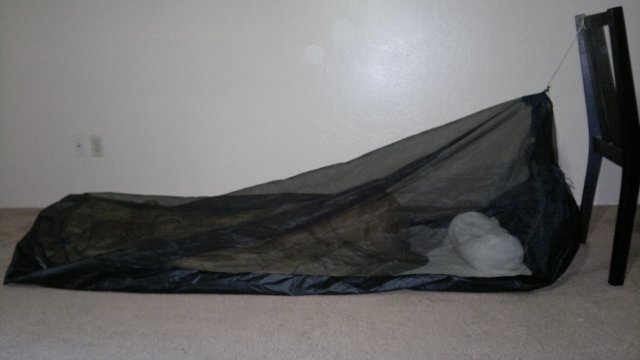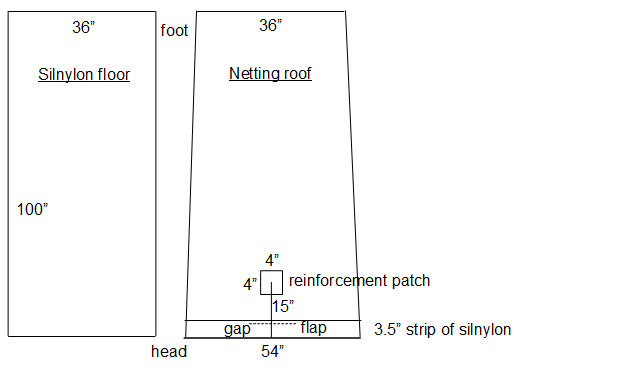Sewing - Bugbivy
All content copyright © 2010-2024 Frank Revelo, www.frankrevelo.com, United States copyright office registration number TX-7931345

Roof suspended from above, such as from ridgeline of tarp. Cord adjusted in length using cordlock.

Roof elevated using pole inserted in polecup inside bugbivy (same pole as used to hold up foot end of tarp, details here), with cord attached to any heavy object (rock, food bag, etc).
Further discussion of bugbivy here.
Weighs about 260 grams (9 oz), including stuff sack, when constructed according to design below, which is for man 71" tall (180 cm). Easy to modify design for larger or smaller users. If modifying design, allow plenty of girth at top, so as to make it easy to get in and out of bugbivy.
- Not much heavier than simple flat groundsheet, but provides full protection from bugs.
- Very easy to sew.
- Can be used either under tarp or in standalone mode.
- Opening closed by drawcord (operated from inside bugbivy), and thus immune to zipper failure.
- Space at front of bugbivy for storing smartphone, sheath knife, other small items.
- Bathtub floor extends almost 8" on either side of ground pad.
1.1 oz ripstop nylon coated is known to be of limited waterproofness when subjected to pressure, plus it will develop holes if placed directly against ground. Thus water which flows under tarp will seep through bottom of bivy. This should not be a problem if using full length ground pad and assuming there is only a small amount of water under tarp (avoid camping on dished ground where rain likely to form a puddle). Durability of silnylon is not a problem, in my experience, since tears in no-see-um netting will usually force replacement of bugbivy long before floor wears out.
Roof at head end elevated either by suspending from tarp ridgeline or other overhead attachment point, or using pole inside bugbivy. Arrange sleep quilt, either over body or pushed into bottom of bugbivy to lift netting there, so that netting does not rest directly against body, since mosquitoes can easily bite through netting. They cannot easily bite through silnylon at lower sides of bugbivy.
Another way to defeat mosquitoes or ticks that might attempt to bite through netting, is to treat netting with permethrin. Note that monofilament polyester (standard no-see-um netting in outdoor fabrics stores is monofilament polyester) does not wick and does not absorb moisture and thus permethrin treatment will not be as effective as it would be with nylon or cotton or multi-filament polyester netting. However, some permethrin should cling even to monofilament polyester netting. It would be better to treat netting before sewing, since permethrin will serve no purpose against silnylon and will tend to stink when silnylon gets wet (at least until it wears off). Permethrin is destroyed by both sunlight and oxygen, and so treatment will only last a few months, at most. I don't treat my bugbivy with permethrin because of ineffectiveness and horrible stink.
My first bugbivy was based on Ray Jardine's original zipperless net-tent design from Beyond Backpacking (forerunner to current Trail Life). I found Jardine's design complicated to sew, nuisance to set up, cumbersome to get into and out of due to small door opening. So I simplified design and made door opening much larger. Bottoms of doors on both Jardine's and my zipperless designs were simple flaps held down by ground pad and other objects. These closures were effective at keeping flying bugs out, but not so effective for crawling bugs, such as ants, spiders, beetles (all of which I encountered when using my zipperless bugbivy) and possibly ticks (which I didn't encounter but which concerned me).
So I then changed to design with a #3 zipper running partway down ridgeseam. This design was very effective at keeping both flying and crawling bugs out. However, zipper failed in two ways. First, it froze shut in cold weather due to condensation from my breath. I was able to unfreeze zipper using body warmth and thereafter made it a rule not to use the zipper if I expected freezing temperatures (not a problem since few bugs when cold). Second, zipper wore to point where it would not stay shut. I fixed this in the field using old trick of squeezing back of slider slightly with pliers on a leatherman multitool (which I then carried in my repair kit but which I no longer carry). But this got me to thinking that I could not really rely on zippers and so switched back to zipperless design, but with drawcord closure rather than just flap of netting. Drawcord closure is just as effective as zipper at keeping out bugs, and much more reliable. Drawcord closure design also somewhat easier to get into and out of than design with zipper on ridgeseam.
Some people use conventional bivy sacks with tarps for protection from both wind-driven rain and bugs. However, conventional bivy sacks are uncomfortable sweatboxes in summer and late spring, at least until sun goes down and things cool off. These are also the seasons with the most bugs. Many conventional bivy sacks provoke feelings of claustrophia, due to being smaller in girth than my bugbivy. Those without zippers tend to be much harder to get into and out of than my bugbivy, due to small opening. Those with zippers have potential for zipper failure.
Commercial bugbivys available as of 2023:
- Oware hot-weather bugbivy. Similar to my design but several flaws, in my opinion: (a) uncoated nylon rather than coated silnylon for floor, for reduced weight and better ventilation; (b) front too narrow, which will make it difficult to get in and out and also interfere with sitting cross-legged on ground pad in morning without also sitting on netting, which will eventually tear netting; (c) no polecup, and hence no way to raise netting when camping on bare rock; (d) no flap to plug gap in opening when drawcord cinched tight; (e) only one cordlock on hanging cord rather than two, with one as a spare.
- Ray Jardine net-tent kit. Jardine had same bug problems with his original net-tent as I had with my zipperless design, and so his current net-tent uses multiple zipper closures and is otherwise quite complicated to sew and to set up in the field. Evidently, Jardine has forgotten about possibility of zipper failures, which he discussed at some length in Beyond Backpacking. (That book has been replaced by Trail Life, which I haven't read so I'm not sure if he still discusses zipper failures at length.)
- Mountain Laurel Designs Bugbivy.
- Outdoor Research BugBivy.
- Various bug shelters available at Backcountry Gear.
Materials:
- 3 yds 1.4 oz/sqyd (after coating) silicone coated ripstop. If difference in slipperiness of two sides of fabric, then more slippery side should face inside bugbivy. Dark color preferred, to speed drying in sun.
- 3 yds 1 oz/sqyd polyester or nylon no-see-um netting, at least 54" wide. Black color preferred since easier to see through black netting at night than white and grey. Polyester absorbs less water and hence dries faster, but nylon more durable.
- Scrap of heavyweight silnylon (2.3 oz/sqyd after coating) or other medium-weight waterproof fabric.
- Scrap of 1000d cordura.
- 2 micro cord-locks, 2 small cord-locks.
- 15 feet 2mm dacron cord.
- 100% polyester sewing thread, 80/12 universal needle for most sewing, 90/14 needel for sewing grommet reinforcement patch.
- Walking foot attachment for sewing machine, if available. Tendency for netting to stretch with regular foot, especially when being sewed to silnylon over long distance.
- Grommets, installation tools. Size #0 (1/4") is ideal for grommet for tunnel. Size #1 (5/16") also works and may be easier to source.
- Razor to cut hole for grommet: fold fabric around grommet location, one fold in each direction, then shave off corner from outside. Cutting corner with scissors is also possible, but tends to make hole too big.

Instructions:
- Use 1/2" seams, unless otherwise specified. Zigzag all edges, since silnylon will eventually fray.
- Cut as shown in pattern.
- Silnylon strip. Trim 3" from head end of netting roof, then sew on a 4" strip of silnylon with 1/2" seam. This 3.5" silnylon strip will be used to create the drawcord tunnel. Without this strip of silnylon, roof part of tunnel would consist of netting, which tends to tear when cinched tight with drawcord.
- Reinforcement patch. Sew 4" squares of heavyweight silnylon to inside and outside of netting roof at location shown in pattern.
- Sew roof to floor. Use straight seam, leaving opening at head end. Because roof sides are cut on diagonal, they may be slightly longer (like 1/4") than floor sides. It should be possible to take up this excess during pinning.
- Box foot end. Final result should be 21" wide by 14" high.
- Tunnel grommet. Cut 2 pieces of cordura 1.5" x 2". Sew to inside and outside of silnylon strip, 1" from opening, over seam allowance. Install grommet. Avoid placing grommet in middle of floor or roof, where cordlock liable to be stepped on or sat upon, thus breaking it. Sewn buttonhole lightweight alternative to metal grommet, but less durable. (TBC My original bugbivy with drawcord used a buttonhole sewn through silnylon, and that buttonhole eventually frayed. Perhaps buttonhole sewn through one or two layers of cordura reinforcement, and then heavily coated with FrayChek, might be durable, and thus eliminate need for grommet.)
- Tunnel. Sew tunnel around opening, about 1.4" wide, for drawcord closure. Avoid narrow tunnels, since difficult to pull drawcord tight if tunnel long but narrow.
- Tunnel drawcord. Insert 2mm dacron cord through grommet and tunnel, secure with cordlock.
- Gap flap. Drawcord leaves gap in opening unless pulled very tight. Even if pulled tight initially, drawcord tends to loosen over time, due to movements of sleeper which pull on bivy fabric. Gap allows bugs to enter. So stitch 6" side of 6" x 12" flap of silnylon to outside of bivy at location shown in pattern. Pulling this flap into opening while tightening drawcord will plug gap. (Using netting for flap would save a few grams of weight, however netting eventually tears and so not advised.)
- (optional) Polecup. Sew 1/4" hem on one 4" side of 4x8" strip of silnylon. Stitch remaining sides with 3/8" seams to form open-ended sack, with slightly more than 1" diameter when formed into circle (rear tarp pole under 1" diameter). Turn inside out. Stitch closed end of sack to center of reinforcement patch to form pole cup. (I almost never use this polecup. Bugbivy can be used standalone without polecup, if camping on rock or inside hut. Polecup with pole inserted merely raises netting off face, to allow reading while lying on my back, before going to sleep on my side.)
- Hanging loop/cord. Bartack folded 1" piece of 2mm dacron to center of polecup reinforcement patch. Insert 72" of 2mm dacron through this small loop. Tie big loop in upper end of cord, install dual micro cordlocks on lower end of cord, with knot on lower end to hold cordlocks in place. Extra cordlock is spare. Cord normally used to suspend roof from tarp ridgeline and 72" much longer than necessary for this purpose. Extra length for use when sleeping without tarp, using some fixed object to elevate roof. Extra length can also be used to pull downwards toward some heavy object, such as rock, to keep internal pole in place when using bugbivy in standalone mode.
- Stuff sack. Use medium size, sewing details here.